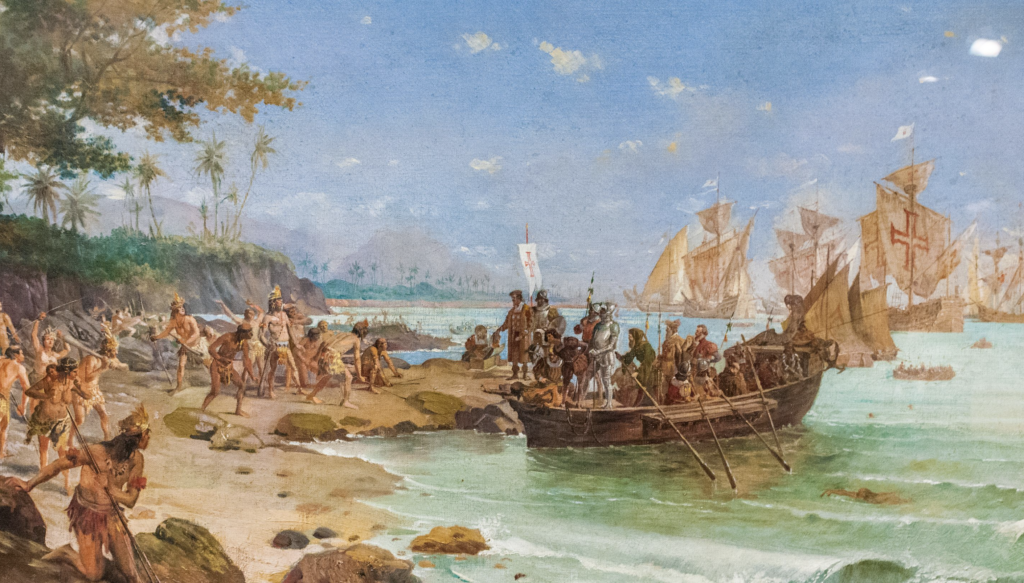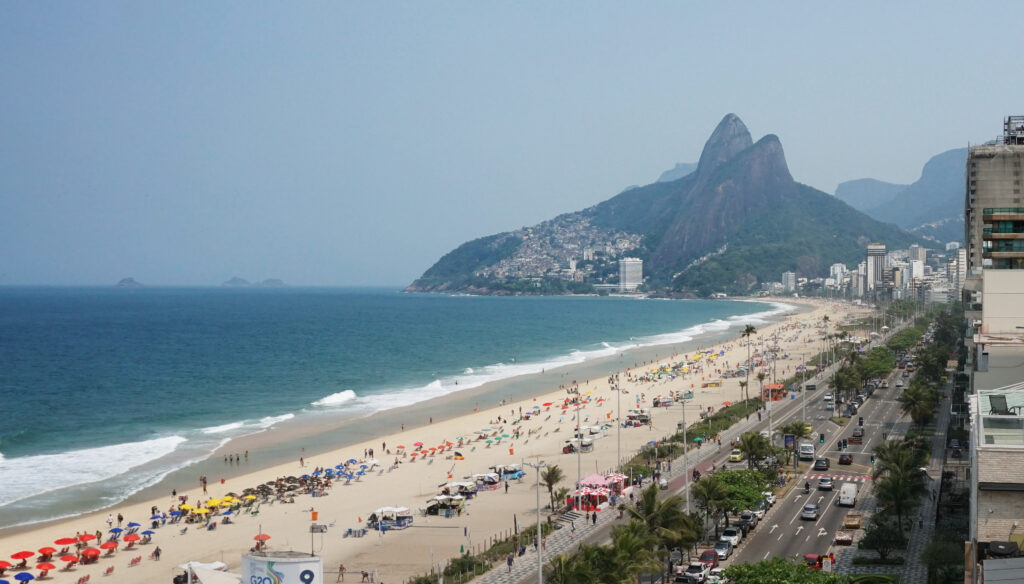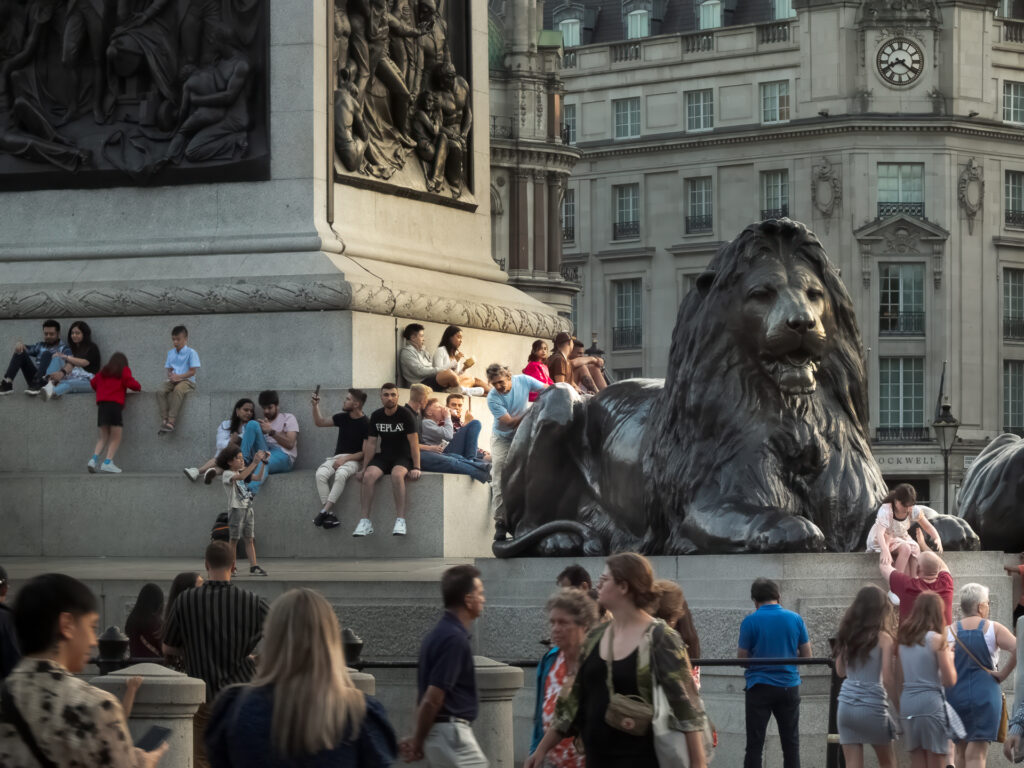Rio de Janeiro means ‘River of January’ in Portuguese. This name was chosen by the explorers who first arrived in their tiny wind-blown ships on January 1, 1502. Can you imagine sailing across the Atlantic on a 75-foot-long wooden sailing ship, bobbing like a cork through storms and high seas? Portuguese caravels were constructed with lots of cork, so when they were buttoned up and away from krakens, they didn’t sink. Not sinking is a small consolation when you’re in the doldrums suffering from scurvy, so they get credit for being tough. This painting portrays the Portuguese arrival in idealized terms. Historical accounts tell a less sanitized encounter. How can a modern tourist expect to fair on a first trip to Brazil?

522 years later, things have changed a lot. We scream across the skies in flaming aluminum cans, touching down in this or that place just long enough to sample the food, stroll the streets, and take pictures so we can check another box on our bucket list.

Modern travel isn’t all comfort. Just because we aren’t braving 20-foot waves without a compass doesn’t mean we don’t face serious challenges. Number one: What camera should we take? Our decision dogs us after we’ve arrived, because on every cobblestone street, in every landscape, and during every magnificent sunset, we may grind our teeth because we don’t have the right lens or camera for the job. Would a wider lens have been better in this next photo?

Magellan was a tough guy and brilliant sailor. Would he have circumnavigated the globe if he’d had to take his eyes off the horizon to dig around in a camera bag for the lens he forgot in his hotel room? It’s entirely possible he would have missed a turn and fallen off the edge of the world. I was determined not to let that happen to me, so I brought three cameras on my trip to Brazil. Each photo indicates which camera was used. Was it worth the trouble? You be the judge. What follows is the saga of my ‘Trio in Rio.’
Cameras: Circa 1954 Zeiss Contessa, Sony A6000, Apple iPhone 14+, and Sony telephoto lens. That’s my nephew’s image on the cell phone.

While I’ve become a reborn film zealot in the last few years, the hope that ‘one camera fits all’ doesn’t work for travel. We photographers must adapt to many opportunities in foreign places. But what camera would I take, if I could only take one? I’d pick my cell phone because of the small form factor, sharpness, High Dynamic Range, and the electronically generated ‘short depth of field’ feature. It always gets the shot. Why bother with anything else?
Most of us agree that cell phones do a great job, but they are the least satisfying camera to use. So, it follows that the most difficult camera of the trio was the one I enjoyed using the most in Brazil. My Zeiss Contessa 35mm.

It’s safe to say, “The best camera is the one you have at the time a great scene presents itself.” Saying something is safe doesn’t make it safe. In the following photo, I don’t think our Leica users would attempt to lean over a railing and take a one-handed photo with an M3. Yet, cell phone users don’t hesitate to do it. A search for how many innocent people died from falling cell phones in the United States turned up a figure of 47 in the period from 2018-2021. An exhaustive search for how many people died from falling Leica cameras revealed zero. That didn’t include how many people died while trying to retrieve a dropped cell phone, operated their cell phone while driving or water skiing, or simply walked off a cliff while viewing their screen. (11 on that last one!)
So, dear readers, if your significant other complains about you spending household money on film cameras, share the statistics with them. Use your cell phone at your own risk!

My next choice would be a smallish digital camera with a couple of zoom lenses. The Sony A6000 fits that bill quite well, and the 80-210 zoom focuses very close! The newer models are better performers than my old 6000, but I’m only spending money on film cameras these days. I’m not sure a newer model could improve upon this shot. This is right out of the camera with an overcast sky in the background. Anyone know the name of this cute animal? It was slightly bigger than a house cat.

The Zeiss Contessa is my third choice of the trio as a travel camera because it’s slow, but it’s my favorite 35mm folding camera. I used to say that about my Kodak Retina II until it decided to fall out of my pocket and plunge through the ice into the Stanislaus River. Sad day. The Zeiss replacement is better in every respect. I’m amazed at the quality of this camera costing less than $200 on eBay. If the photographer is good at guessing distances and exposure, the Contessa will deliver shots that rival a Nikon or Leica. The sharpness of the next photo shocked me when I viewed the negative. I nailed the focus by setting the lens at three feet and moving into the subject, so her face was four inches beyond the fingertips of my left hand. I don’t recommend doing this with a Hells Angel or Ethiopian pirate, but I warned this young woman what I was attempting and she smiled…a little nervously. BTW, I was wide open at f/2.8 @ 1/125sec with FP4. LUCKY! This was my favorite shot of the trip.

Back to the travel experience: Rio isn’t a city with classic colonial architecture that cries out to be captured in B&W. It’s famous for music, food, beaches, and vitality. The nightlife is absolutely a color subject, and what better camera to use than a cell phone? Nobody objects to that format in a night club.

These next three images were taken with the Sony A6000. Because the high ISO images are quite sharp, it’s also a good camera for sniper shooting. No photo collection of Rio would be complete without bikini sunbathers. Ipanema beach is internationally known for the great vocal version of a song performed by vocalist Astrud Gilberto and sax player Stan Getz. The original song was written by Antonia Carlos Jobim and Vinicius de Moraes. There have been many stories about the writing of “The Girl From Ipanema,” and they are all entertaining. The most likely is that Antonio and Vinicius often sat in a cafe to watch girls, and one specific one, Heloisa Pinto, caught their eye almost every day. She was a high school student walking home, not a girl in a bikini. Astrud Gilberto, Antonio’s wife, recorded the song as a demo until the record producer could hire a ‘real vocalist.’ That never happened. The demo got out and became a huge hit. Nobody knew the girl from Ipanema’s real name for nearly 35 years after the song became famous. There was a national search and Heloisa was found. She never got any royalties, but became a local heroine for the inspiration she provided! Astrud left Antonio and ran away with Stan Getz!! There’s more to Ipanema than meets the eye.



Lastly, and most dear to my heart, are some more Contessa B&W shots. This tiny camera is both inconspicuous and intriguing to photo subjects. Large cameras with big lenses put people off. It’s not unreasonable to assume that a massive machine is going to steal your spirit for profit. A little vintage folding camera changes the equation to, “Oh, look, an old man with a toy camera!”

Sao Paulo is the New York of Brazil. There has been a lot of international investment and urban renewal in the area surrounding the old downtown, making a ring of new buildings with a blighted center. The center area is home to thousands of desperate people, many living in abandoned buildings with no electricity or running water. Brazilians warned us not to walk through that area, even in broad daylight.

The central market in Sao Paulo is the beating heart of the city. It’s housed in a large building with enormous arched windows and skylights. Even though it’s in the old section of town, there’s enough security personnel on duty to make it safe for shopping. This is where the middle class go for almost everything.

There are endless food stalls in the market with inexpensive fresh foods. We chose a place that “Makes the best sandwiches in Sao Paulo.” I can’t argue with that description. This next photo is of Chef Esmeralda, the owner of the sandwich shop. It was shot with HP5 pushed to 800 and processed in HC-110 dilution B. Use of a monopod was necessary with an exposure of 1/60 @ f3.5. I did several shots of her, hoping to nail the focus on at least one. This type of portraiture requires your subject to be a collaborator because of the fiddling needed to get an old folding camera set correctly. In this case it paid off.

The Pinocoteca de Estado Museum is a must-see location in Sao Paulo. As I was taking this photo, a woman stepped into the light for a few seconds. Sometimes the photo gods are watching and helping!

Let’s close this article with a shot of me standing next to a hippie van in the Vila Madalena district of Sao Paulo. This van is much too new to be a real hippie van, but it did have California license plates!!

— Technical notes: In past articles I’ve been very disappointed with the poor appearance of my copy shots of prints. This time I spent the extra effort to do macro shots of my negatives with the Sony A6000 and a vintage Nikkor 55mm macro lens. This allowed me to post process the images, which turned out much better. If you like the results and are looking for a way to set up an inexpensive rig, check out my earlier article on that subject.
Share this post:









Comments
Martin on A Camera Trio in Rio
Comment posted: 05/12/2024
Comment posted: 05/12/2024
Stephen Scarlett on A Camera Trio in Rio
Comment posted: 05/12/2024
Comment posted: 05/12/2024
Comment posted: 05/12/2024
Luc Costa on A Camera Trio in Rio
Comment posted: 05/12/2024
Geoff Chaplin on A Camera Trio in Rio
Comment posted: 06/12/2024
Comment posted: 06/12/2024
David Hill on A Camera Trio in Rio
Comment posted: 14/12/2024
Second, I need to take issue with your quip that “Portuguese caravels were constructed with lots of cork, so when they were buttoned up and away from krakens, they didn’t sink.” Ahem .. Early caravels were often framed in cork, that is, their heavy timbers were made from the /wood/ of the cork oak tree. This is the tree whose /bark/ gives us that impermeable bouyant stuff we make wine bottle stoppers and floaty things from. But the wood of the cork oak is like any other wood, and it didn’t make caravels any safer than any other ship of its era. Caravels were small, without space to waste, and shipbuilders were many centuries away from the concept of building ships that could survive swamping—or any other safety measures…
But stunning pics. Thank you...
Comment posted: 14/12/2024